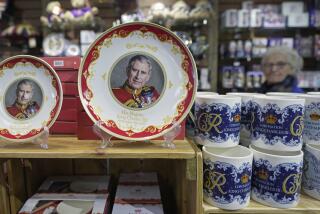QE2 to Host Queen, Royal Family
- Share via
The celebrations for Cunard’s 150th anniversary will start July 27 with a “Spithead Review” at the port of Spithead, near Southampton.
Her Majesty Queen Elizabeth and other members of the Royal Family, from the yacht Britannia, will review the QE2 and Cunard’s Vistafjord, along with a flotilla of British Royal Navy vessels.
Afterward, the queen will attend a luncheon on board the QE2. An aerial display and fly-over by the Royal Air Force has been scheduled, and the same evening, passengers on the QE2 will attend a star-studded variety show and a laser-light and fireworks display.
It all began a century and a half ago with Samuel Cunard. “I want a plain and comfortable boat, not the least unnecessary expense for show,” he instructed a Scottish shipyard that built his 1,154-ton paddle-wheel steamer Britannia in 1840.
To Cunard, the 63 passengers were almost an afterthought when the Britannia set out on its maiden voyage from Liverpool to Halifax and Boston on July 4, 1840, with 93 crew members and a cow to supply fresh milk on the voyage.
Far more important to the conservative businessman from Halifax, Nova Scotia, was the lucrative transatlantic mail service.
And, from the accounts of the Britannia’s most notable passenger, Charles Dickens, who sailed the North Atlantic through a series of gales in January, 1842, there was little of the luxury that is associated with present-day crossings on modern ships.
“Not ill, but going to be,” he wrote tersely in “American Notes.” His cabin contained “a very flat quilt, covering a very thin mattress, spread like a surgical plaster on a most inaccessible shelf.” The dining room, he wrote, was “not unlike a gigantic hearse with windows in the sides.”
Breakfast was served at 10 a.m., dinner at 4 p.m. and supper, a light meal, at 7 p.m.
There were no napkins because, as one Cunard executive said, “Going to sea is a hardship. The Cunard Co. does not undertake to make anything else out of it, and if people want to wipe their mouths at a ship’s table, they could use their pocket handkerchiefs.”
With three sister steamers--Columbia, Acadia and Caledonia--constructed that same year, Cunard was able to reduce transatlantic mail delivery and passenger crossings from six weeks to two weeks.
A century later, in 1940, the 100th anniversary went without fanfare. It was the first summer of World War II, after the fall of France and the battle of Dunkirk.
Cunard had just completed the largest passenger ship ever built, the 83,673-ton Queen Elizabeth (predecessor of today’s smaller Queen Elizabeth 2), when it was called to war with its sister ship, the Queen Mary (now permanently berthed in Long Beach).
As the QE2 crosses from Southampton to New York City beginning July 28, activities will include a “Bootlegger’s Ball” and a “Black and White Ball.” During the sailing, concerts by the Royal Philharmonic Orchestra will be conducted by Andre Previn and will feature guest pianist Cristina Ortiz.
Passengers can book the five-day transatlantic crossing for $2,190 to $10,600 per person, double occupancy, which includes a one-way British Airways economy flight or, for an additional $995, a one-way British Airways Concorde flight from New York City, Miami or Washington, D.C.
On Sept. 1, the QE2 will sail from New York City to Boston, Cunard’s first port, and Halifax, birthplace of Samuel Cunard, on a four-day celebration cruise that will be highlighted by a “150th Anniversary Ball” and a “150th Anniversary Spectacular.”
Prices for this sailing start at $800 per person, double occupancy, and go up to $3,340 per person, double occupancy.
More to Read
Sign up for The Wild
We’ll help you find the best places to hike, bike and run, as well as the perfect silent spots for meditation and yoga.
You may occasionally receive promotional content from the Los Angeles Times.





